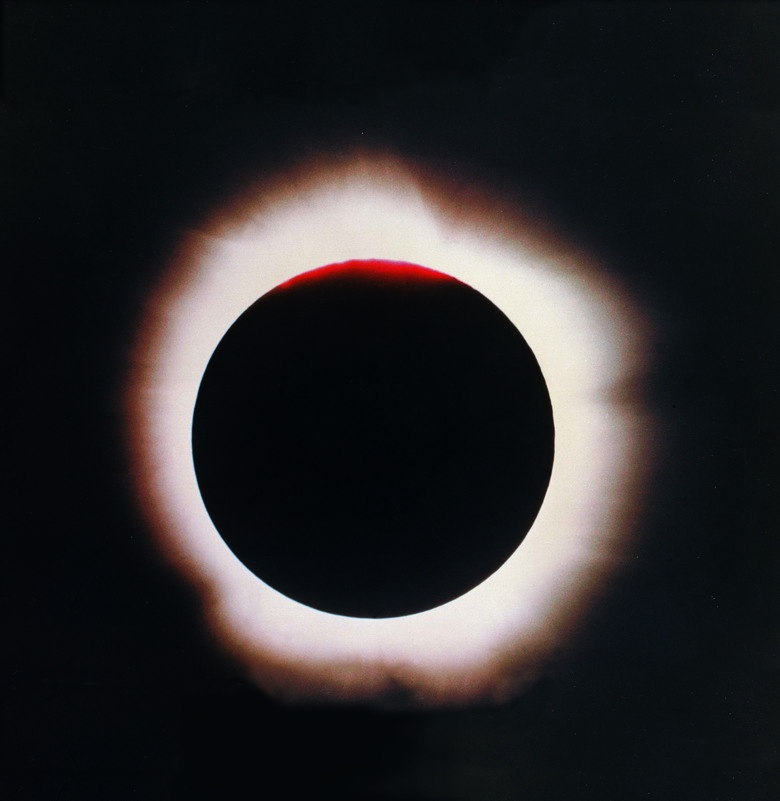Ideas For A Solar Eclipse Project For High School Students
Don't save solar eclipse projects for the science fair. You can recreate the phenomena that accompany the different types of solar eclipses whether you're at school or in your own backyard. With a little planning and research you'll have the tools you need to understand and appreciate each phase of the eclipse, impressing your friends and family as you explain the hows and whys of the aligning Earth, sun and moon.
Create a Photo Banner
Probably the easiest way to demonstrate a solar eclipse is to create a photo sequence. Start with several pieces of black construction paper, representing space. Use a glass to trace and cut out multiple circles on yellow and white pieces of construction paper for your sun and moon, respectively. Create the first panel by taping a yellow cutout in the center of space (the black paper), with the moon off to the left. Add some rays around the sun for artistic effect. Set up progressive panels by moving the moon cutout incrementally over the sun until they are evenly stacked. Tape banner panels together and hang them. You can also create a banner showing the different types of eclipses (i.e., partial, annular, hybrid and total).
Create an Animated Video
Create an Animated Video
Using a single black background and cutouts for the Earth and moon, you can use a similar process to create an animated video. To create a video, put your digital camera on a tripod so you can maintain its position and distance from your project. Create the video frame by placing the yellow cutout in the center of space, with the moon off to the left. Take a picture for your video. Move the moon cutout to the right a bit and take another picture. Keeping moving it incrementally over the sun until they are evenly stacked. Download your digital photos to a computer and use an application such as Microsoft Movie Maker to create your video.
Build a Model
Build a Model
A paper model assumes the audience is the Earth and doesn't really demonstrate the full elliptical rotations of the Earth, sun and moon. To show the moon's shadow as it is cast on the Earth during a solar eclipse, build a model. You'll need items to represent your celestial bodies. Consider foam balls from the craft store, paper mache creations or balloons for the Earth and moon. Choose items proportionate to the real things. Use a flashlight to represent your sun. Color or paint your Earth and moon appropriately. You'll need some type of pedestal to hold up the Earth and string to tie around or tape to your moon. Prop up the flashlight on a few books at one end of the table and your Earth on its pedestal at the other end. Turn on the flashlight and, holding the string, slowly move the moon across the path of light and observe the shadow it casts on Earth.
Create a Calendar
Create a Calendar
Solar eclipses don't occur as often as lunar eclipses and aren't visible everywhere on the planet. As one of your projects, you can create a solar eclipse calendar that pinpoints the days and locations of upcoming events. The NASA Eclipse Website lists all past and future eclipses. Decide whether you want to create a calendar for a geographic region or for a particular type of eclipse. You can use a Microsoft Word calendar template or your favorite calendar software to create monthly calendars for the next calendar year. Extract necessary dates from the NASA Eclipse website and plug them into your calendar. You could also use the coordinates provided on the NASA site to pinpoint dates on a world map. Clicking the "Calendar Date" link will open a global map of the particular eclipse's coverage area, including the point of the greatest eclipse.
Cite This Article
MLA
Polisena, Joanna. "Ideas For A Solar Eclipse Project For High School Students" sciencing.com, https://www.sciencing.com/ideas-solar-eclipse-project-high-school-students-12310367/. 24 April 2017.
APA
Polisena, Joanna. (2017, April 24). Ideas For A Solar Eclipse Project For High School Students. sciencing.com. Retrieved from https://www.sciencing.com/ideas-solar-eclipse-project-high-school-students-12310367/
Chicago
Polisena, Joanna. Ideas For A Solar Eclipse Project For High School Students last modified August 30, 2022. https://www.sciencing.com/ideas-solar-eclipse-project-high-school-students-12310367/
